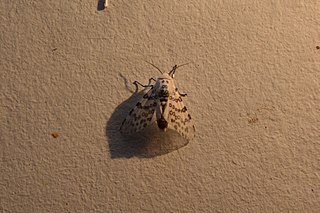
The Arctiini are a tribe of tiger moths in the family Erebidae.

Chetone catilina is a moth of the family Erebidae. It was described by Pieter Cramer in 1775. It is found in French Guiana, Venezuela and Suriname.
Hypercompe albescens is a moth of the family Erebidae first described by George Hampson in 1901. It is found in Guatemala.

Hypercompe albicornis is a moth of the family Erebidae first described by Augustus Radcliffe Grote in 1865. It is found on Cuba.
Hypercompe atra is a moth of the family Erebidae first described by Charles Oberthür in 1881. It is found in Mexico.
Hypercompe bari is a moth of the family Erebidae first described by Charles Oberthür in 1881. It is found in French Guiana.
Hypercompe brasiliensis is a moth of the family Erebidae first described by Charles Oberthür in 1881. It is found in Brazil and French Guiana.

Hypercompe cunigunda is a moth of the family Erebidae first described by Caspar Stoll in 1781. It is found in French Guiana, Suriname, Brazil, Venezuela, Ecuador and Bolivia.
Hypercompe deflorata is a moth of the family Erebidae first described by Johan Christian Fabricius in 1775. It is found in Ecuador.
Hypercompe gaujoni is a moth of the family Erebidae first described by Paul Dognin in 1889. It is found in Ecuador.

Hypercompe icasia is a moth of the family Erebidae first described by Pieter Cramer in 1777. It is widely distributed in South America and is also found on Martinique, Guadeloupe, Saint Martin, Dominica, St. Kitts, Nevis, St. Thomas, and Puerto Rico.

Hypercompe indecisa is a moth of the family Erebidae first described by Francis Walker in 1855. It is found in Argentina and Uruguay.

Hypercompe kinkelini is a moth of the family Erebidae first described by Hermann Burmeister in 1880. It is found in Argentina.
Hypercompe magdalenae is a moth of the family Erebidae first described by Charles Oberthür in 1881. It is found in Colombia and Bolivia.
Hypercompe obsolescens is a moth of the family Erebidae first described by George Hampson in 1916. It is found in Peru.
Hypercompe ocularia, the ocularia leopard, is a moth of the family Erebidae. The species was first described by Johan Christian Fabricius in 1775.
Hypercompe orsa is a moth of the family Erebidae first described by Pieter Cramer in 1777. It is found in Suriname.
Hypercompe simplex is a moth of the family Erebidae first described by Francis Walker in 1855. It is found in Puerto Rico, as well as on the Virgin Islands and the Lesser Antilles.
Hypercompe theophila is a moth of the family Erebidae first described by Paul Dognin in 1902. It is found in Colombia.
Sychesia dryas is a moth in the family Erebidae. It was described by Pieter Cramer in 1775. It is found on the West Indies, Guatemala, Costa Rica, French Guiana, Brazil, Peru, Ecuador, Bolivia, Suriname, Venezuela and Trinidad.






